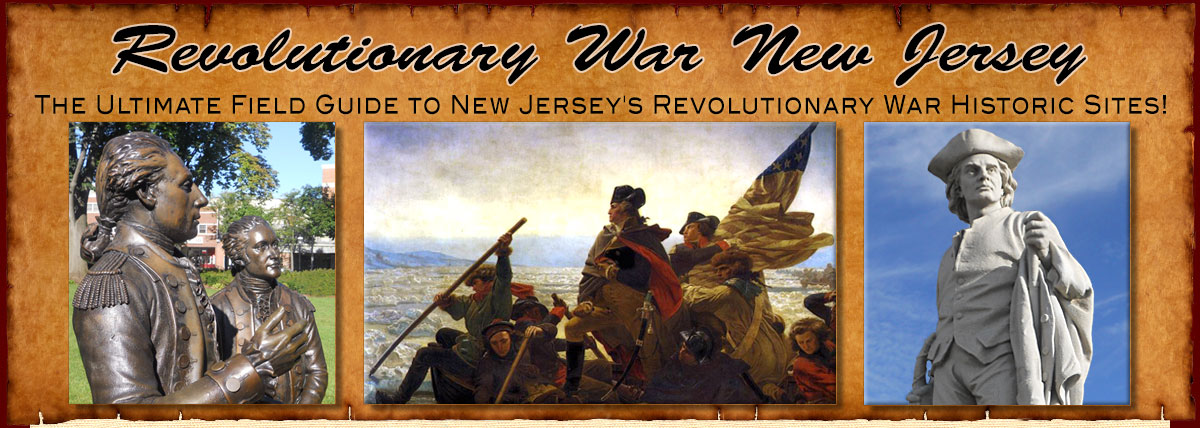
Wayne was named for Anthony Wayne, an American General in the Revolutionary War.

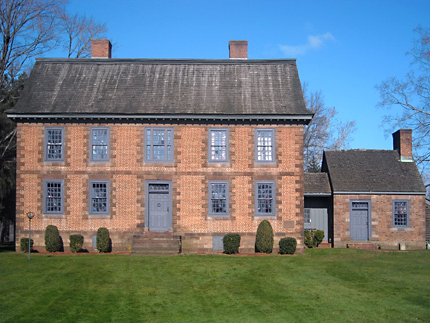
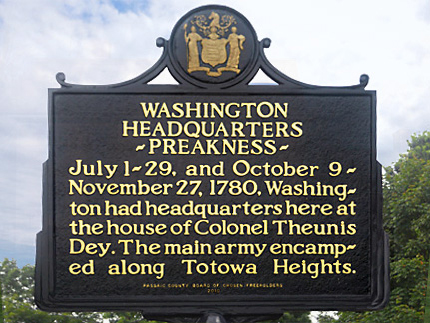
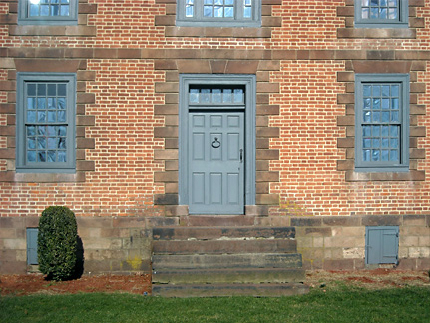
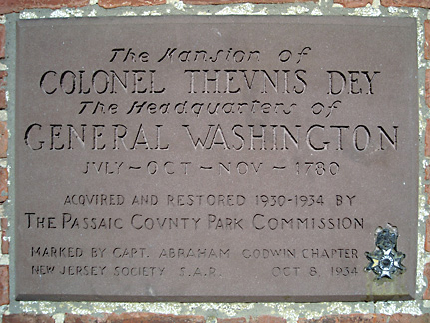
Dey Mansion / Washington's Headquarters Museum
199 Totowa Road
Map / Directions to Dey Mansion
Map / Directions to all Wayne Revolutionary War Sites
For current hours and admission information,
see the Dey Mansion Web Page
This house was built circa 1770. At the time of the Revolutionary War, it was the home of Colonel Theunis Dey and his wife Hester. Theunis was a Colonel in the Bergen County militia, and he was also active politically in the Revolutionary War era. [1] Hester also took part in the cause of Independence; she served on a committee of women who raised money for the "relief and encouragement of those brave Men of the Continental Army." [2]
Dey Mansion served as General George Washington's Headquarters twice during the Revolutionary War: from July 1 - 29, 1780, [3] and again from October 9 - November 27, 1780. [4] Washington and his close aides, who he referred to as his "military family," occupied the east side of the house. Theunis and Hester Dey remained at the house with their children and occupied the rooms on the west side.
One of the officers staying with Washington at Dey Mansion was his aide-de-camp Alexander Hamilton. Hamilton wrote the following love letter to his then-fiancée Elizabeth "Betsey" Schuyler on July 6. [5] (The couple married five months later, on December 14.)
Col Dey's house Bergen
County
July 6th.
To Elizabeth Schuyler
Here we are my love in a house of great hospitality—in a country of plenty—a buxom girl under the same roof—pleasing [expect]ations of a successful campaign—and every thing to make a soldier happy, who is not in love and absent from his mistress. As this is my case I cannot be happy; but it is a maxim of my life to enjoy the present good with the highest relish & to soften the present evil by a hope of future good. I alleviate the pain of absence by looking forward to that delightful period which gives us to each other forever; and my imagination serves up such a feast of pleasure as almost makes me forget the deprivation I now experience. But alas my Dear girl this does not always do. The illusion will not always sooth[e]; my heart every now and then cries: You are separated from the lovely partner of your life; four long months must elapse before this separation ends; your sweet girl with nothing to engage or divert her attention is perhaps suffering the keenest anxiety for the situation of her lover not only absent from her but exposed to a thousand imaginary dangers.
But my dearest quiet your apprehensions (for I know your tender fond mind is of too apprehensive a cast) and let your thoughts run only upon those delights which our reunion will afford.
Assure yourself my love that you are seldom a moment absent from my mind, that I think of you constantly and talk of you frequently, I am never happier than when I can engage [Colonel] Meade in some solitary walk to join me in reciprocating the praises of his widow and my betsey.
Adieu my angel, be happy and love me as well as I love you
A Hamilton
While Washington was headquartered at Dey Mansion, thousands of Continental Army troops were encamped throughout an area that makes up modern-day Totowa, Woodland Park, Little Falls, and Hawthorne. [6] Some of Washington's well-known generals commanded troops in these encampments, including Lord Stirling, Henry Knox, Anthony Wayne, and the Marquis de Lafayette. All of these generals visited Washington at Dey Mansion during his stay here.
During the month of July, Lafayette made his own headquarters a mile away from Dey Mansion at the Van Saun House. (See the Van Saun House entry lower on this page.)
Dey Mansion Today [7]
Dey Mansion is now a museum, open to the public for tours. The museum is filled with furniture and paintings from the Revolutionary War era, and is arranged to show the rooms as they might have been when Washington was here. Most of the wooden floors in the house are original. The interior walls have been painted in what tests have determined were the original colors. Theunis and Hester Dey are buried in unmarked graves in a small cemetery near the house, within Preakness Valley Golf Course. Click here for more information about visiting Dey Mansion.

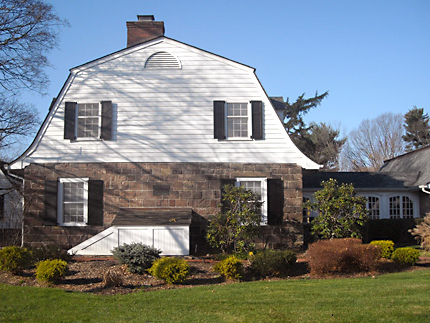
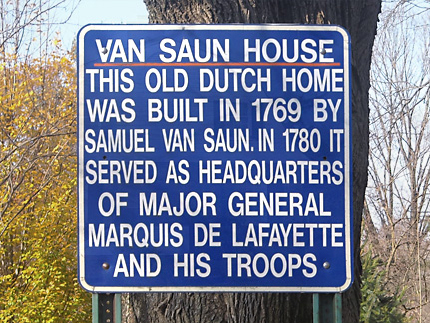
Van Saun House Lafayette Headquarters
23 Laauwe Avenue
Map / Directions to the Van Saun House
Map / Directions to all Wayne Revolutionary War Sites
This house is a private residence.
Please respect the privacy and property of the owners.
During General Washington's stay at Dey Mansion in July 1780, General Marquis De Lafayette made his headquarters at this house. Lafayette was a French officer who came to America to fight on the American side in the Revolutionary War. He became close to Washington, Hamilton, and other Revolutionary War figures.
Lafayette was headquartered at the Van Saun house during the early part of the month, but he had left by July 20 to travel to Newport, Rhode Island to greet the French General Rochambeau, who had just arrived in America with thousands of French troops to fight on the American side in the war. [8]
When Washington returned to the Dey Mansion in October-November 1780, Lafayette did not return to the Van Saun House. He was instead stationed with his light infantry troops at what is now Hawthorne . [9]

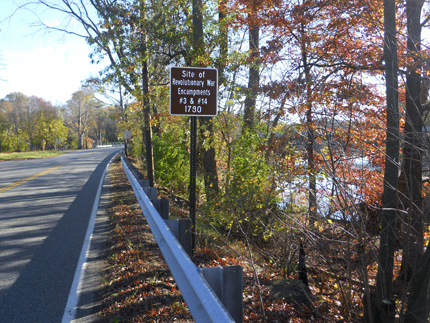
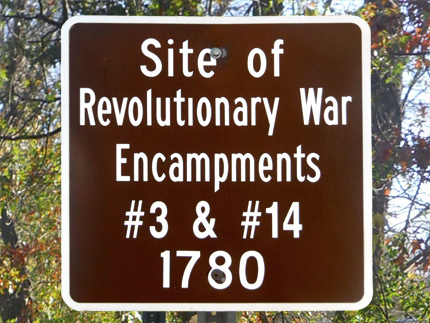
1780 Encampment Site Marker
Two Bridges Rd., about 100 yards west from the two bridges, along the Passaic River near Lincoln Blvd.
Map / Directions to the Encampment Site Marker
Map / Directions to all Wayne Revolutionary War Sites
Two Bridges Road gets its name from the fact that it has two bridges which cross the Passaic River and the Pompton River. During the 1780 encampments, the New Jersey Brigade camped near the Two Bridges. [10] The encampment's post office was also located near the Two Bridges. [11]

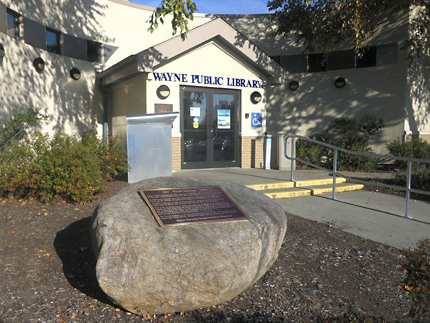
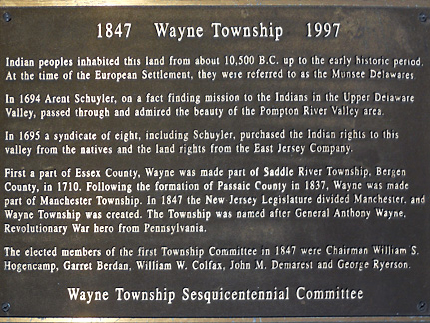
Wayne Township History Boulder Monument
In front of the Wayne Public Library
475 Valley Rd.
Map / Directions to the Wayne Public Library
Map / Directions to all Wayne Revolutionary War Sites
The plaque on this boulder monument describes the history of Wayne Township, including that it was named for Revolutionary War General Anthony Wayne in 1847. [12]
Wayne (January 1, 1745 - December 15, 1796) was known as "Mad Anthony" Wayne. He was from Pennsylvania, but he spent a considerable amount of time in New Jersey during the war. He was in the area of what is now Wayne Township during the encampments of July and October/November 1780 described in the three entries above. [13]
The plaque also contains information about Arent Schuyler, who built the Schuyler-Colfax House described in the entry below.

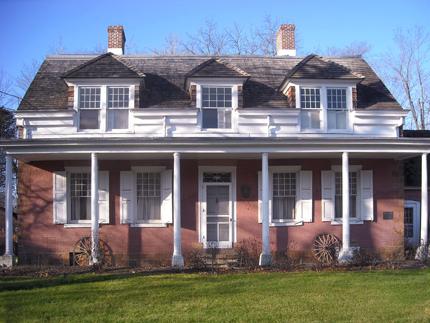
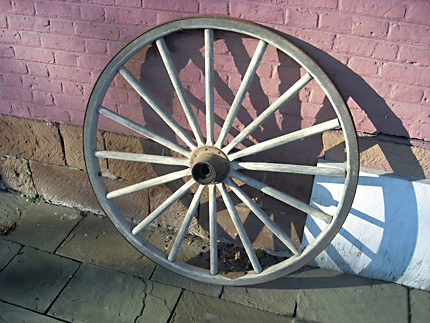
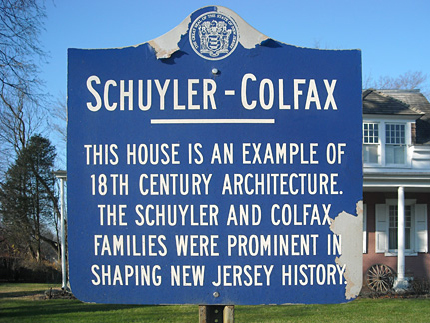
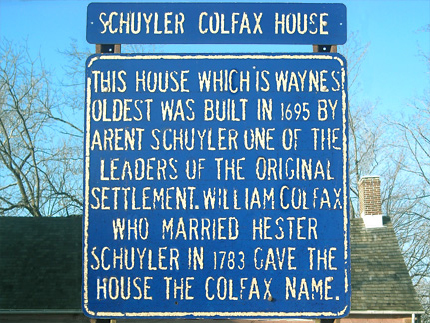
Schuyler-Colfax House
2343 Hamburg Turnpike
Map / Directions to the Schuyler-Colfax House
Map / Directions to all Wayne Revolutionary War Sites
The house is currently undergoing restoration and is not open to the public.
Schuyler-Colfax House Website
This house was built in 1695 by Arent Schuyler, one of the original settlers of this area. It is the oldest house in Wayne, and was already eighty years old at the beginning of the Revolutionary War. [14]
On August 27, 1783, Arent's granddaughter, Hester Schuyler, married William Colfax, who served as a Lieutenant and then a Captain in Washington's Life Guard during the Revolutionary War. [15] The Life Guard was Washington's group of personal body guards, about 150 men who accompanied him throughout the war. [16] William and Hester lived in the house after they were married.
Just six days after the marriage of William and Hester, the Treaty of Paris was signed, officially ending the Revolutionary War, although due to the slowness of ship travel across the Atlantic Ocean at that time, the news of the treaty's signing did not reach America until October 31.
William Colfax was active politically and militarily after the Revolutionary War ended. He represented Bergen County in the New Jersey Legislature from 1806-1813. He was made a Brigadier General in the Bergen County militia in 1810, and he served in that capacity in the War of 1812. [17] (Although Wayne is now part of Passaic County, this area was then part of Bergen County. Passaic County was not created until 1837. [18])
William and Hester are both buried at the Colfax Family Burying Ground (shown below), which is located about a hundred yards north of the house on Hamburg Turnpike.
General George Washington may have visited or used this house as his headquarters at two different times during the Revolutionary War: July 11-14, 1777, and March 30-31, 1782. (See the Washington Headquarters Marker entry on the Pompton Lakes page for more information about this.) [19]
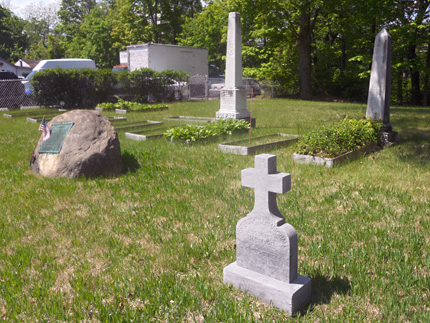
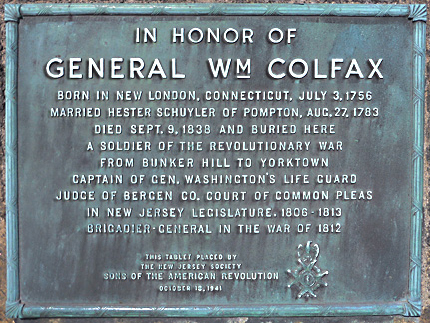

1. ^ Several positions held by Theunis Dey in the Revolutionary War era appear below, along with source material:
• Committee to select delegates to the first Continental Congress:
The New-York Gazette : and the Weekly Mercury, No 1184, July 4, 1774, reprinted in:
Archives of the State of New Jersey First Series, Volume XXIX (Paterson: The Call Printing and Publishing Co., 1917) Pages 411 - 412
Available to be read at the Internet Archive here• Representative for Bergen County in the General Assembly of the Colony of New Jersey, 1775:
Minutes of the Provincial Congress and the Council of Safety of the State of New Jersey (Trenton: Naar, Day & Naar, 1879) Page 63
Available to be read at the Internet Archive here• Committee of Correspondence for Bergen County:
Minutes of the Provincial Congress and the Council of Safety of the State of New Jersey (Trenton: Naar, Day & Naar, 1879) Pages 115 - 116
Available to be read at the Internet Archive here• Appointment as Colonel in the Bergen County Militia:
Minutes of the Provincial Congress and the Council of Safety of the State of New Jersey (Trenton: Naar, Day & Naar, 1879) Page 394
Available to be read at the Internet Archive here
▸ See also:
William S. Stryker, Official Register of the Officers and Men of New Jersey in the Revolutionary War (Trenton: Wm. T. Nicholson & Co., 1872) pages 343 and 353
Available to be read at Google Books here
2. ^ "Trenton, July 4, 1780. The Ladies of Trenton...," New Jersey Gazette, Vol. III, No. 132, July 5, 1780. Reprinted in:
William Nelson, editor, Archives of the State of New Jersey, Second Series, Vol IV (Documents Relating to the Revolutionary History of the State of New Jersey / Extracts from American Newspapers Relating to New Jersey) (Trenton: State Gazette Publishing Company, 1914) pages 486-488
Available to be read at Google Books here3. ^ Most of Washington's letters from July 1-29, 1780 are marked as having been sent from Col. Dey's, Preakness (referring to the Preakness Valley, where the house is located), or Bergen County (this area was then part of Bergen County. Passaic County was not created until 1837. See source note # 5.)
These letters are Available to be read at the National Archives / Founders Online website here• Washington's General Orders for July 28, which are marked "Pracaness" [Preakness] make it clear that the army was to march out the following morning, July 29.
“General Orders, 28 July 1780,” Founders Online, National Archives, https://founders.archives.gov/documents/Washington/03-27-02-0281. [Original source: The Papers of George Washington, Revolutionary War Series, vol. 27, 5 July–27 August 1780, ed. Benjamin L. Huggins. Charlottesville: University of Virginia Press, 2019, p. 334.]• Washington recorded a $50 expense for gratuities for the servants of Dey Mansion when he left the house on July 29, 1780:
George Washington, John C. Fitzpatrick, George Washington's Accounts of Expenses While Commander-in-chief of the Continental Army, 1775-1783: Reproduced in Facsimile, with Annotations (Boston and New York: Houghton Mifflin Company, 1917) Page 66
Available to be read at Google Books here4. ^ Many of Washington's letters from October 9 - November 27, 1780 are marked as having been sent from Preakness, near Passaic Falls (referring to the Great Falls in Paterson, which are 2.5 miles east of Dey Mansion) or Totowa (Totowa in that era referred to a larger area than the modern-day borough of Totowa. In fact, although Dey Mansion is in present-day Wayne, it is only about 1000 feet from the Totowa border.)
Available to be read at the National Archives / Founders Online website here• Washington's General Orders for November 26, which are marked "Headquarters Totowa," make it clear that the army was to march out the following morning, November 27.
“General Orders, 26 November 1780,” Founders Online, National Archives, https://founders.archives.gov/documents/Washington/03-29-02-0225. [Original source: The Papers of George Washington, Revolutionary War Series, vol. 29, 28 October–31 December 1780, ed. William M. Ferraro. Charlottesville: University of Virginia Press, 2021, pp. 343–345.]• Marquis de Chastellux, Travels in North-America, in the Years 1780—81—82 (American Edition, reprinting the text of an edition translated into English and released in 1787) (New York, 1828) Pages 62 - 76
Available to be read at the Internet Archive here
▸ Chastellux describes his November 1780 visit to Washington at Dey Mansion, and his visits to the surrounding encampments.
Although he does not name the house as Dey Mansion, this is clearly the house he is talking about.5. ^ “From Alexander Hamilton to Elizabeth Schuyler, 6 July [1780],” Founders Online, National Archives (http://founders.archives.gov/documents/Hamilton/01-02-02-0751 [last update: 2016-03-28]). Source: The Papers of Alexander Hamilton, vol. 2, 1779–1781, ed. Harold C. Syrett. New York: Columbia University Press, 1961, pp. 353–354.
6. ^ "William Nelson, "Washington's Headquarters at Preakness," The Magazine of American History with Notes and Queries, Volume 3 (New York and Chicago: A. S. Barnes & Company, 1879) Pages 490-495
Available to be read at Google Books here7. ^ Information about the contents and furnishings of the house, as well as other details about Dey Mansion, was obtained during a tour of the house.
8. ^ Tradition places Lafayette's headquarters during this period in the Van Saun House.
Historian William Nelson, writing in 1879, stated that he was informed of Lafayette's use of the Van Saun House "by Samuel A. Van Saun, Esq., of Paterson, grandson of Samuel Van Saun":
"William Nelson, "Washington's Headquarters at Preakness," The Magazine of American History with Notes and Queries, Volume 3 (New York and Chicago: A. S. Barnes & Company, 1879) Pages 490 and footnote #2 on Page 495
Available to be read at Google Books here• A letter written by Lafayette to Washington on July 4, 1780 is marked as being sent from "Camp at precaness [Preakness]":
~ “To George Washington from Major General Lafayette, 4 July 1780,” Founders Online, National Archives, https://founders.archives.gov/documents/Washington/03-26-02-0494. [Original source: The Papers of George Washington, Revolutionary War Series, vol. 26, 13 May–4 July 1780, ed. William M. Ferraro. Charlottesville: University of Virginia Press, 2018, pp. 644–646.]• A letter written by Lafayette to Washington on July 16, 1780 is marked simply as being sent from "Camp," but since Lafayette references "our Conversation of last Night," it can be assumed that he was still at the Van Saun house, close enough to have met with Washington to speak with him the previous night.
~ “To George Washington from Major General Lafayette, 16 July 1780,” Founders Online, National Archives, https://founders.archives.gov/documents/Washington/03-27-02-0120. [Original source: The Papers of George Washington, Revolutionary War Series, vol. 27, 5 July–27 August 1780, ed. Benjamin L. Huggins. Charlottesville: University of Virginia Press, 2019, pp. 147–150.]• Lafayette had clearly left the area by the July 20, and did not return to New Jersey during July. This can be seen in his letters from July 20-29.
~ His letter to George Washington dated July 20 is marked Peekskill, NY, so he had left the Van Saun House by July 20:
◦“To George Washington from Major General Lafayette, 20 July 1780,” Founders Online, National Archives, https://founders.archives.gov/documents/Washington/03-27-02-0176. [Original source: The Papers of George Washington, Revolutionary War Series, vol. 27, 5 July–27 August 1780, ed. Benjamin L. Huggins. Charlottesville: University of Virginia Press, 2019, pp. 207–208.]
~ His letters from July 21 - 29 are marked as being sent from places in New York, Connecticut and Rhode Island, showing the trip he made to Newport.
◦ These letters are available to be read at the National Archives / Founders Online website here.• Note that there is a plaque on the Van Saun house which incorrectly states that it was used as Lafayette's headquarters in November 1780. The plaque was placed by the William Paterson Chapter of the D.A.R. in 1931.
9. ^ Information about Lafayette's October-November 1780 encampment in Hawthorne, along with accompanying source notes, can be found on the Hawthorne page of this website.
10. ^ Orderly Book of the New Jersey Brigade, July 30 to October 8, 1780, From the Original Manuscript in the New York Public Library (Published by the Bergen County Historical Society, 1922) Pages 3-4
Available to be read at Google Books here
▸ This book begins at July 30, and so does not give any account of the location of the New Jersey brigade earlier in July.
It should also be noted that this orderly book shows that the New Jersey Brigade remained at Two Bridges until July 31, staying behind for two days after General Washington and most of the other troops had left on July 29.11. ^ “General Orders, 12 July 1780,” Founders Online, National Archives, https://founders.archives.gov/documents/Washington/03-27-02-0067. [Original source: The Papers of George Washington, Revolutionary War Series, vol. 27, 5 July–27 August 1780, ed. Benjamin L. Huggins. Charlottesville: University of Virginia Press, 2019, pp. 85–86.]
• Another mention of the Two Bridges was made in Washington's General Orders from three days before, which stated, "Application to be made tomorrow morning to the Deputy Clothier General near the two Bridges for the respective Proportion of Shoes for the Troops."
“General Orders, 9 July 1780,” Founders Online, National Archives, https://founders.archives.gov/documents/Washington/03-27-02-0030. [Original source: The Papers of George Washington, Revolutionary War Series, vol. 27, 5 July–27 August 1780, ed. Benjamin L. Huggins. Charlottesville: University of Virginia Press, 2019, pp. 39–40.]12. ^ Plaque placed by the Wayne Township Sesquicentennial Committee in 1847.
See also:
John F. Snyder, The Story of New Jersey's Civil Boundaries: 1606-1968 (Trenton: Bureau of Geology and Topography, 1969) page 201
Available as a PDF on the State of New Jersey website here. (Note that although the information is on the page numbered 201 of the document, it is on page 199 of the PDF file.)13. ^ Wayne's letters from this period are almost all marked as being sent from Totowa.
Many can be read at the National Archives / Founders Online website:
July 1780 letters
October/November 1780 letters14. ^ House history information drawn from the Historic House Museums, Structures and Sites page on the Township of Wayne website, and the signs in front of the house.
• For more about Arent Schuyler, see the Wayne Township History Boulder Monument entry on this page.
15. ^ Wedding date from the plaque honoring William Colfax in the Colfax Family Cemetery, placed by the New Jersey Society of the Sons of the American Revolution, October 18, 1841
• William Colfax's service and ranks in the Life Guard from:
~ Harry M. Ward, George Washington's Enforcers: Policing the Continental Army (Carbondale IL, Southern Illinois University Press, 2006) Page 60
~ Carlos E. Godfrey, The Commander-in-chief's Guard, Revolutionary War (Washington D.C.: Stevenson-Smith Company, 1904) Pages 139-141
▸ ▸ Some letters exchanged between George Washington and William Colfax are available to be read at the National Archives/Founders Online website here
16. ^ For a more detailed description of the Life Guard, with accompanying source notes, see the Washington's Life Guard Camp Site Monument entry on the Morristown page of this website.
17. ^ Plaque honoring William Colfax in the Colfax Family Cemetery, placed by the New Jersey Society of the Sons of the American Revolution, October 18, 1841
• Colfax is listed representing Bergen County in editions of the Journal of the Proceedings of the Legislative-Council of the State of New-Jersey from this period. Several are available to be read at Google Books: 1808, 1809, 1810, 1812 and 1813
• Colfax's appointment as a Brigadier General in the Bergen County Militia on November 10, 1810 is documented in:
Journal of the Proceedings of the Legislative-Council of the State of New-Jersey (Elizabethtown, NJ: Printed by Shepard Kollock, one of the Printers to the State, 1810) Pages 202-203
Available to be read at Google Books here18. ^ John F. Snyder, The Story of New Jersey's Civil Boundaries: 1606-1968 (Trenton: Bureau of Geology and Topography, 1969) page 209
Available as a PDF on the State of New Jersey website here.
(Note that although the information is on the page numbered 201 of the document, it is on page 198 of the PDF file.)19. ^ Details of Washington's stays in Pompton on July 11-14, 1777, and March 30-31, 1782, can be found in the Washington Headquarters Marker entry on the Pompton Lakes page along with accompanying source notes.